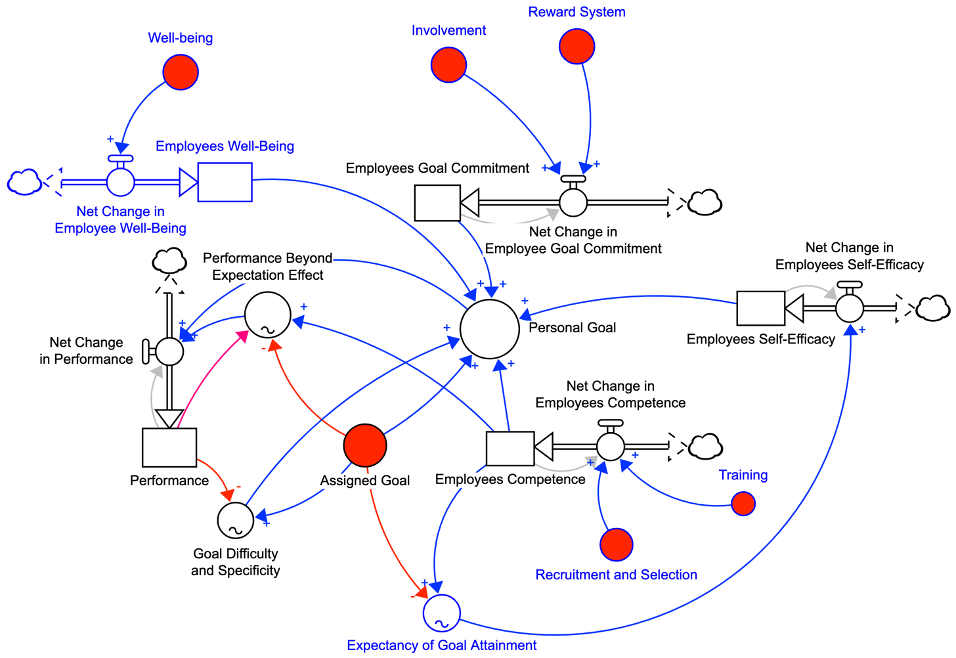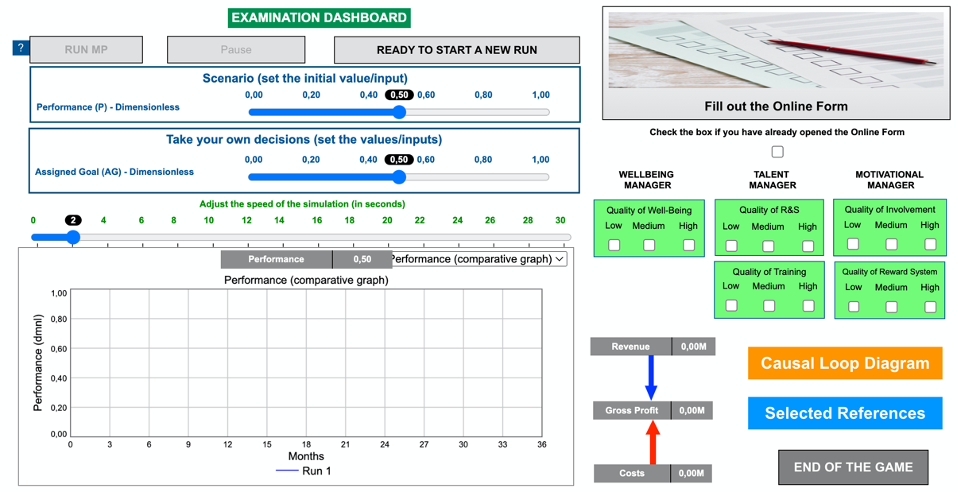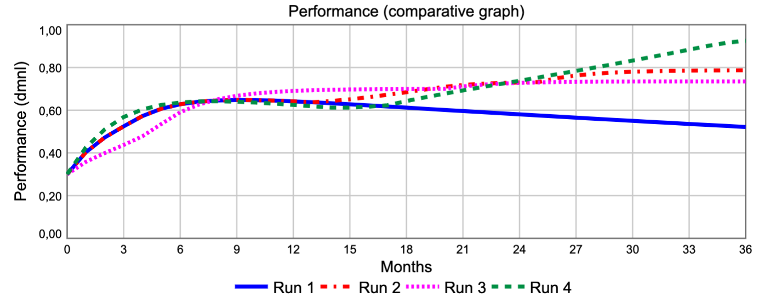An online system dynamics-based interactive learning environment (ILE) can be designed to assess the trainees' capabilities, in accordance with the formative assessment paradigm. Through a simulated business environment, trainees have the opportunity to virtually manage their own company (system) while taking on various roles that mirror real-life scenarios related to the phenomenon analyzed by the ILE. The ILE has a feature that allows the assessment of such capabilities by measuring key indicators that determine the feasibility, effectiveness, and efficiency of their decision-making when running a firm within a specific operational context. From this standpoint, implementing a practical approach that enables trainees to confidently evaluate their capabilities in a protected environment (simulations) would produce the following different benefits for them: a) Personalized Learning: Interactive learning environments can adapt to suit trainees' individual learning styles, making the learning experience more personalized and effective; b) Interactive Learning Experience: Interactive learning environments offer learners the opportunity to engage actively in the learning process, facilitating better retention of knowledge; c) Real-time Feedback: Interactive learning environments provide learners with instant feedback, which helps them to identify gaps in their knowledge and improve immediately; d) Collaborative Learning: Interactive learning environments encourage learners to work collaboratively, which has proven benefits for memory retention and enhanced peer learning.
- interactive learning environment
- formative assessment
- educational entrepreneurship
- competence assessment
- work and organizational psychology
- training
- system dynamics
1. Introduction
The significance of formative assessment and feedback in enhancing learning is acknowledged by many scholars ([1]). A scholar ([2]) indicates that formative assessment is highly successful in increasing students' achievement, and incorporating it into teaching improves trainees performance. Formative assessment also aids in the development of skills such as explaining, interpreting, and reasoning. Providing timely and informative feedback through formative assessment has several advantages. Formative assessment is essential for a teacher's ability to modify their lessons and ensure trainees understanding.
Formative assessment, also known as assessment for learning, refers to evaluations of trainee performance that are designed to assist trainees in achieving their learning objectives ([3]). This is distinct from formative evaluation, which involves evaluating how to enhance a program's effectiveness over time. Summative assessments are used to evaluate how well trainees have learned at the end of a teaching sequence, whereas formative assessments are used to make judgments about trainees' progress in order to guide future instruction. Formative assessments, which offer timely and informative feedback to trainees, can be regarded as a form of learning or assessments as learning because they are intended to help trainees improve their comprehension ([4]).
2. Formative Self-Assessment
Instead of solely relying on the traditional teacher-to-trainee feedback model, there are other important methods to foster trainee learning. Self-assessment and peer assessment are two key components that provide valuable feedback for trainees' development. These methods enable trainees to reflect on their own performance and give feedback to their peers, which is a crucial part of the assessment process. Implementing evidence-centered design, formative assessment frameworks, and computerized assessments can improve the learning experience for both teachers and trainees, as well as help validate assessments through technology. Research by Sadler and Good [5] indicates that trainees must learn to evaluate their own work by comparing it to high-quality examples, which promotes meta-cognitive and self-regulation skills, leading to more effective learning.
3. System Dynamics-Based Interactive Learning Environment as a Tool for Formative Assessment
Ellis's research [6], along with other scholars, has identified a historical limitation in enhancing formative assessment, which is the widespread existence of face-to-face courses. This made it challenging to record and analyze learning interactions and results for formative feedback and evaluation. Nevertheless, recent technological developments have provided numerous opportunities to collect and analyze data related to performance and assessment. These data offer significant insights into trainees' progress in various educational activities.
While certain automated systems, such as system dynamics-based ILEs, can capture data, the critical factor is the effective use of this data. Proper utilization of data can greatly help both learners and teachers, as emphasized by several authors [7].
A new online learning platform - Interactive Learning Environment (ILE) - can be created to evaluate how well trainees can manage performance. This ILE follows the formative assessment approach. It takes the form of an interactive game, which can be played by one person or multiple players. In this game, participants (trainees) have specific goals that they must accomplish and then analyze how their decisions impact the overall functioning of a virtual company.
4. The structure of the ILE
4.1 The ILE Interface
The interface provides players with details about the company's profile, the duties assigned to trainees in multiplayer games, and the roles and responsibilities of team members in multiplayer games. The ILE dashboard shows the current and assigned goals, as well as the values of various other factors, such as performance (present and desired performance) and income statement (revenue, costs, and profit).
The ILE interface typically displays a causal loop diagram (CLD) that demonstrates the primary causal relationships among system variables. The CLD is a useful tool for visualizing the feedback structure of systems and can serve multiple purposes, including:
- Rapidly capturing ideas about the reasons behind dynamic behaviors.
- Gathering and documenting the cognitive models of individuals or teams.
- Conveying the important feedback loops that are thought to contribute to a problem
A Causal Loop Diagram (CLD) is a graphical representation that consists of variables linked by arrows, showing the causal relationships among them. The diagram also points out significant feedback loops and categorizes them as positive (reinforcing) or negative (balancing). Figure 1 displays an example of CLD of an ILE, with arrows indicating causal connections between variables. Each causal connection is labeled with a positive (+) or negative (-) polarity, which shows how the dependent variable changes in response to changes in the independent variable. Specific loop identifiers are assigned to highlight critical loops, distinguishing between positive and negative feedback. A positive link signifies that an increase in the cause results in a more significant increase in the effect, and a decrease in the cause leads to a more substantial decrease in the effect. In contrast, a negative link indicates that an increase in the cause results in a decrease in the effect, while a decrease in the cause leads to an increase in the effect.

Figure 1. An example of causal loop diagram (CLD) of the ILE (from: [8])
4.2 The ILE Dashboard
The simulation interface includes both the controls for the user to manipulate the simulation and the visuals that display the simulation's effects. Another way to describe the simulation interface is to explain that it serves as the means by which simulation inputs and outputs are generated and presented (Figure 2).

Figure 2. An example of an ILE dashboard (from: [8])
During each run, the player(s) make various decisions, including changing the initial performance value (scenario), setting the value of the assigned goal (expected or desired performance), and managing the available system levers in order to achieve the desired or assigned goals (figure 3).
At the end of each run, the player(s) are required to complete an online form, where they provide an explanation of the (theoretical) reasons behind the system's behavior, drawing upon the scenario and decisions made.

Figure 3. An example of graphs of a simulation session (from: [8])
4.3 The ILE Features to Support the Online Formative Assessment Procedures
The online formative assessment is possible thanks to two main functions provided by the software (for example, Stella Architect by isee System) used to create the ILE, and the online platform (for example, isee Exchange) for publishing the ILE on the internet: authentication and data collection.
Authentication allows the teacher to control access to their simulations and only allow specific individuals (participants) to enter. Instead of being able to easily view the simulation through a web browser, individuals need to log into the online platform and have received an invitation from the teacher. If unauthorized people try to view the simulation, they will receive an error message.
Data collection is a useful method for monitoring and recording user behavior during a published simulation. User activity is transmitted to the online platform at different points, such as when the simulation is paused or completed. Setting up data collection for multiplayer games is the same as for single-user simulations. In multiplayer games, the user's name is reported as the game's name or team name.
4. Conclusion
The system dynamics-based ILE has the potential to improve learning and knowledge transfer by applying a system dynamics model and simulation. Therefore, it can be effectively used in various educational programs. The ILE encourages users to engage in formative self-assessment by running simulations and observing how the system reacts to their chosen scenarios and decisions. Participants can assess and analyze the outcomes, comparing different scenarios and decisions to evaluate the effectiveness of their entrepreneurial strategies. During simulations, participants can actively intervene and modify variables within the system, seeing how these changes impact overall performance. Simulations also offer the chance to explore hypothetical future scenarios and evaluate the long-term consequences of current decisions.
This entry is adapted from the peer-reviewed paper 10.3390/admsci14010003
References
- Black, P.; Dylan W. Assessment for learning in the classroom. In Assessment and Learning; Gardner, J., Eds.; Sage Publications: London, 2006; pp. -.
- Hattie, J. Visible Learning for Teachers: Maximizing Impact on Learnings; , Eds.; Routledge: New York, 2012; pp. -.
- Spector, J. M.; Ifenthaler, D.; Sampson, D.; Yang, L.; Mukama, E.; Warusavitarana, A.; Dona, K.L.; Eichhorn, K.; Fluck, A.; Huang, R. and et al.; et al. Technology enhanced formative assessment for 21st century learning. Educational Technology & Society 2016, 19, 58–71, .
- Spector, J. M. Foundations of Educational Technology: Integrative Approaches and Interdisciplinary Perspectives; Routledge: New York, 2015; pp. -.
- Sadler, P.M.; Good, E.; The Impact of Self- and Peer-Grading on Student Learning. Educ. Assess. 2006, 11, 1-31, .
- Ellis, C.; Broadening the scope and increasing the usefulness of learning analytics: The case for assessment analytics. Br. J. Educ. Technol. 2013, 44, 662-664, .
- Spector, J.M.; Conceptualizing the emerging field of smart learning environments. Smart Learn. Environ. 2014, 1, 2, .
- Ceresia, F.; A System Dynamics-Based Interactive Learning Environment for Online Formative (Self-)Assessment of Wanna-Be Entrepreneurs’ Performance Management Capabilities. Adm. Sci. 2024, 1, 3, .
